
|
 |
Vessels & Voyages > Vessels
& Vehicles
Vessels & Vehicles
 |
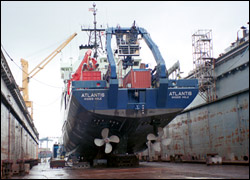 |
| A rare look
below the water line: R/V Atlantis during scheduled
maintenance in the Bahamas in April. (Photo by Bob Elder) |
R/V Atlantis and DSV Alvin
Research Vessel (R/V) Atlantis
spent 2003 sailing regions of the Pacific and Atlantic oceans
supporting deep submergence projects. Deep Submergence Vehicle
(DSV) Alvin, which operates from Atlantis,
made 100 dives and carried 300 pilots and passengers last year
during scientific expeditions to the Mid-Atlantic Ridge, the
New England Seamounts, the Gulf of Mexico, and the East Pacific
Rise.
Atlantis operates around the clock. Alvin
typically dives in the morning, spends the day at the bottom
of the sea, and is recovered in the late afternoon. At night,
while the Alvin team prepares the submersible for the
next day’s dive, the ship performs research operations such
as mapping, collection of dredge or water samples, and towing
of instruments.
Science operations began in March with a cruise to test Britain’s
new Remotely Operated Vehicle (ROV) Isis (a clone of
ROV Jason II), capable of diving to 21,325 feet (6,500
meters). In April, researchers on Atlantis visited
the massive hydrothermal vent field “Lost City” for the second
time since scientists discovered the site while diving in Alvin
in 2000. On May 16, 2003, Alvin pilot Pat Hickey marked
his 500th dive while sampling there for mussels and carbonates.
In early June the ship sailed to the New England Seamounts, where scientists collected corals that record climate change signals. A cruise in late June to the Mid-Atlantic Ridge focused on the seismicity, structure, and fluid flow of hydrothermal systems. Other summer cruises included an expedition to study species biodiversity at the New England Seamounts and a cruise off the southeastern United States focused on the biology, physics, and chemistry of seafloor methane seeps.
Atlantis returned to Woods Hole in August for scheduled
maintenance. In October science operations resumed with a trip
to the Gulf of Mexico for the study of chemosynthetic communities.
After traveling through the Panama Canal, Atlantis
sailed to the East Pacific Rise, where scientists using Alvin
collected biological samples. A second visit to the site in
November and December allowed researchers to continue studies
of the tubeworms that live on chimneys at hydrothermal vent
fields.
 |
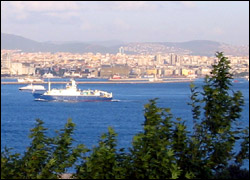 |
| Knorr
arrives in Istanbul, Turkey. (Photo by Chris Roman) |
R/V Knorr
The longest ship at WHOI at 279 feet (85 meters), Knorr
can operate worldwide in any ice-free waters. Like Oceanus,
Knorr is a general-purpose ship.
Knorr is outfitted with thrusters and global positioning
system navigation, and in 2003 received a new computer-controlled
dynamic positioning system that allows the ship to hold its
position to within three feet (one meter). This is an important
capability for operations such as drilling core samples and
operating tethered vehicles.
In early January, Knorr traveled to the Adriatic Sea
to support an Office of Naval Research (ONR) cruise to measure
seawater mixing, before sailing to the Black Sea for three months
of National Science Foundation (NSF) sponsored chemistry, physical
oceanography, and marine archaeology research. The ship returned
to the Adriatic in late May and June for scientists to complete
research on ocean circulation.
Following maintenance in Malta, Knorr spent July and August
at deep-sea archaeological sites in the Black Sea and the Mediterranean.
As Knorr traveled back across the Atlantic to Woods
Hole, scientists and engineers tested a new underwater video
microscope, called a video plankton recorder, that measures
the distribution of plankton. In October and November, a cruise
supported scientists conducting an extensive hydrographic survey
between Woods Hole, Newfoundland, and Trinidad.
 |
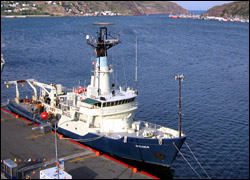 |
| Oceanus
in Newfoundland. (Photo by Ryan Frazier) |
R/V Oceanus
At 177 feet (54 meters), Oceanus is a mid-size research
vessel designed for cruises lasting two to three weeks. The
ship is equipped for deploying deep ocean moorings; collecting
bottom samples, water samples, and data to depths of 16,404
feet (5,000 meters); and towing oceanographic instruments that
measure seawater properties, biological populations, and other
physical and chemical variables. Following a mid-life upgrade
in 1994, the service life of Oceanus was extended to
2009.
Working the Atlantic Ocean from the equator to the Arctic Circle,
Oceanus supported research projects in nearly every
oceanographic discipline in 2003, and even gave some students
a first taste of scientific work at sea.
On separate cruises in January and February to the tropical
Atlantic, researchers and technicians used Oceanus
to recover and redeploy moorings that measure meteorological
conditions at the sea surface and the flow of deep water from
the Antarctic into the Atlantic circulation system. Between those cruises,
the ship tracked the movement of a tracer dye that was released
in 2001 in order to measure mixing in the top layers of the
tropical ocean.
On a March cruise for the NSF Engineering Research
Center, researchers conducted tests of autonomous underwater
vehicles. Two cruises for ONR in April and May focused on the
acoustic properties of the Atlantic Ocean along the U.S. continental
shelf, while a third ONR expedition in November collected data
on how fluid dynamics in the sea can affect the propagation
of acoustic signals.
A summer cruise in the Gulf of Maine studied the characteristics
of Alexandrium fundyense, algae known to poison shellfish.
Further north, the ship supported cruises in July and August
to the Labrador, Irminger, and Greenland Seas to collect data
on the flow of water into and out of polar regions.
The ship supported a January oceanographic training
cruise from Woods Hole to Brazil for undergraduate students
from the University of Maryland.
 |
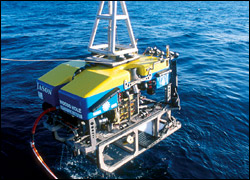 |
| Remotely
Operated Vehicle Jason II. (Photo by Dan Fornari) |
ROV Jason II
ROV Jason II spent the entire year in the Pacific Ocean
working from the R/V Thomas G. Thompson. Through five
expeditions, Jason II was lowered 47 times, logging
752 hours on the seafloor and reaching its diving limit—21,325
feet (6,500 meters)—on several dives.
In the Mariana Forearc region off Southeast Asia, in March Jason
II conducted a precision mapping campaign of four seamounts
and collected samples of mud, rock, and seafloor organisms.
In June, the ROV explored the Endeavour hydrothermal vent field
on the Juan de Fuca Ridge off Washington state, drilling into
basalt and sulfide formations to deploy in situ instruments
and to take samples of high-temperature fluid flow sites. On
a second trip to the Ridge in July, Jason II collected
wood and organism samples as well as more than 200 gallons of
fluid from active hydrothermal vents for a research team investigating
the origins of life on the seafloor.
On two other cruises in
May and September, the ROV was used to upgrade and install new
instruments at the Hawaii-2 Observatory (H2O), which lies on
the seafloor halfway between Hawaii and California. Researchers
used the vehicle to recover and redeploy the H2O junction box,
augmenting and extending the utility of the only U.S. deep-ocean
observatory. Among other instruments, the team installed a new
seismometer system to monitor earthquakes and submarine landslides,
as well as a photographic monitoring system to observe sea creatures
that pass through the area.
 |
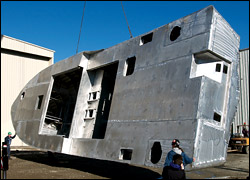 |
| Rollover
of the new 60-foot coastal research vessel Tioga
in November. The new vessel arrived at WHOI in April 2004,
and replaces the 24-year-old Asterias. (Photo
by Tom Kleindinst) |
R/V Tioga
After 24 years of coastal research, the 46-foot (14-meter) vessel
Asterias completed its final year of science work in
2003. Asterias performed 643 hours of service last
year, with cruises supporting the growing demand for coastal
research, primarily in the New England region. The vessel will
be sold in spring 2004 to be replaced by the new 60-foot (18-meter)
Tioga (shown under construction in photo at right), capable of
cruising at 20 knots, twice as fast as the vessel it replaces.
Tioga will carry twice the weight and feature state-of-the-art
laboratories while supporting shallow water diving operations.
—Richard F. Pittenger (rpittenger@whoi.edu)
Vice President for Marine Operations
|
|
